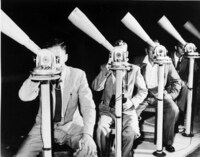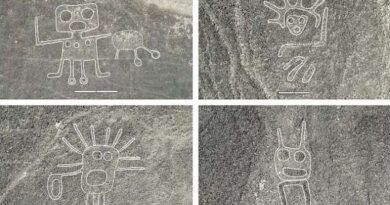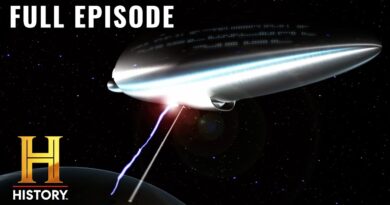Wonder if UFOs are real? The government has been trying to find out, too.

Pilot Clarence Chiles and co-pilot John Whitted were flying a commercial jet from Houston to Atlanta when they saw a bright light coming right at them, skimming the sky too fast to be another plane, at least by 1948 standards. The aircraft looked like a plane’s fuselage, clipped of its wings, glowing blue beneath its body. After it zoomed by, the object shot a flame from its back end and then sped off into the clouds. The Air Force investigated this eerie event as part of Project Sign, its first UFO research program.
This is one of many flying saucer stories, each full of sensory detail, that appears in “UFO: The Inside Story of the U.S. Government’s Search for Alien Life Here — and Out There,” by historian and journalist Garrett M. Graff. In three chronological sections, Graff looks at decades of federal, private and scientific research into unidentified flying objects and their relationship to hypothetical alien life.
Although nothing concrete links UFOs to extraterrestrials, the two are forged in public consciousness. “The question that people really are asking when they ask if UFOs are real: Are we alone?” Graff writes. This is, in essence, the question at the heart of his book.
Graff, whose books include “Watergate: A New History” and “The Only Plane in the Sky,” explores the past 80 or so years of UFO history, providing ample detail of the players and programs and primary source material. The modern story of UFOs often begins, as it does here, with the confluence of two events in 1947: A pilot named Kenneth Arnold, swooping around near Mount Rainier, saw nine shiny objects flying faster than anything he’d ever seen. Right around the time of Arnold’s sighting, something crashed outside of Roswell, N.M. The military at first declared it a flying saucer, then a weather balloon.
These sightings precipitated a flood of UFO reports. Though officials were skeptical, the reports raised concerns about national security. “Was the U.S. being probed by a secret Soviet space weapon?” Graff writes of the thinking at the time. Officials feared that the Soviets were surveilling terrestrial developments, like Chuck Yeager’s sound-barrier-breaking efforts. “Secret, world-changing projects like Yeager’s were a big reason that the military was so concerned about the waves of flying saucer sightings,” Graff writes.
These worries ultimately motivated the Defense Department to begin a series of studies about UFOs: Project Sign, Grudge and Blue Book all investigated saucer stories, over the course of more than 20 years. The general conclusion of these government studies remained consistent. Air Force Colonel Robert Landry summed the sentiment up well early on, stating reports he provided quarterly to President Truman, “Nothing of substance considered credible or threatening to the country was ever received from intelligence.” A panel convened to review Project Blue Book stated that within the more than 10,000 sightings in its database “there appears to be no verified and fully satisfactory evidence of any case that is clearly outside the framework of presently known science and technology.” Given that, Graff writes, “they suggested that the focus on the UFO question be moved out of the realm of national security.”
Such conclusions can sow suspicions, in part because the government hasn’t always dealt with UFOs transparently. The object that crashed in Roswell, for instance, wasn’t a weather balloon. It was part of Project Mogul, a nuclear detonation detection system, a connection that had (changed slightly because Mogul was declassified earlier, but not connected to Roswell till the 90s) only came to light in the 1990s, after public and political pressure. The military had lied.
Early in the book, Graff writes that “the government’s UFO coverup has primarily been a coverup motivated not by knowledge but of ignorance. It’s not that the government knows something it doesn’t want to tell us; it’s that the government is uncomfortable telling us it doesn’t know anything at all.” What the book doesn’t quite concede is that there might not, in fact, be much to know.
Today, though, the military is trying, once again, to know whatever there is to know. And after a trek through the past, Graff’s book lands in that present, where officials prefer to call UFOs UAP: unidentified aerial, or sometimes anomalous, phenomena. The serious-sounding terminology is meant to mirror the renewed gravity of the topic, a shift whose start Graff attributes to events in 2017: That year, news stories revealed an effort called the Advanced Aerospace Weapon System Applications Program, which ran for about five years and ended in 2012. According to Graff’s description, the program studied UAP; the Pentagon, for the record, has said in public statements that don’t appear in the book that “the examination of UAP observations was not the purpose.”
Nevertheless, the existence of the program, its description in news coverage, and the UFO videos that accompanied it, changed the game. “They did actually lead to something new: a genuine — and apparently so far, lasting — change in the public perception around UFOs,” he writes. The Department of Defense has since created an office to deal with UAP, the military made guidelines for reporting strange sights, and NASA has undertaken a scientific study.
But the reader would perhaps better understand the story of UFOS if Graff drew explicit parallels between the past and present, because the story of UFOs is nothing if not cyclical: Sightings lead to media coverage, which leads to national security concern, which leads to official study, which leads to media coverage, till everyone gets tired. The parallels are more granular, too: For instance, Edward Ruppelt, who led both Project Grudge and Project Blue Book for a time, made a linguistic change to remove stigma. “We don’t like the term ‘flying saucers,’” he said, “and only rarely use it because it seems to represent weird stories, hoaxes, etc. — sort of a joke. We don’t take ‘flying saucers’ too seriously either, but we do take the problem of Unidentified Flying Objects seriously.” That quote appears in Graff’s book and would have been a useful place to acknowledge that the echo in the change decades later, when officials nixed “UFO” in favor of “UAP,” because the once-sterile acronym, introduced during the Grudge era, is now connotatively tainted in the same way as its flying-saucer predecessor.
Graff knows that connotation — the alien one — isn’t technically part of the denotative definition of “UFO.” “All ‘UFO’ technically implies is exactly what it stands for: something in the sky of unknown origin,” Graff observes early in the book. But his book’s structure draws the connection anyway. Interspersed with the chapters about UFOs are chapters about the largely unrelated searches for life in the universe: seeking alien radio signals, researching Mars’s habitability, understanding the initial appearance of water on Earth. Nothing in the evidence Graff provides connects the two faces of the book together. They simply sit side by side, separate hemispheres that Graff can’t quite weld into one orb.
Sarah Scoles is a science journalist and author of “Making Contact: Jill Tarter and the Search for Extraterrestrial Intelligence,” “They Are Already Here: UFO Culture and Why We See Saucers,” and the forthcoming “Mass Defect: Life in the New Nuclear Age.”
The Inside Story of the U.S. Government’s Search for Alien Life Here — and Out There
By Garrett M. Graff
Avid Reader. 544 pp. $32.50
This article has been archived for your research. The original version from The Washington Post can be found here.


